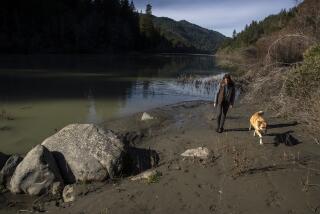Turtle bone found in 1800s had been missing its other half -- till now
- Share via
Two halves of the same turtle’s arm bone were discovered almost 200 years apart, according to a new study.
A fossil miracle? Totally.
“When two pieces of a fossil fit together, they fit perfectly like a puzzle piece,” said Jason Schein, an assistant curator of natural history at the New Jersey State Museum, who was in the room when the two bone halves were first reunited. “We were just kind of dumbfounded.”
You can see pictures of the two halves in the gallery above, as well as an artist’s rendering of the giant sea turtle (with a human diver for scale).
Scientists believe the turtle the bone belonged to lived 70 million to 75 million years ago, in a shallow sea that covered what is now central New Jersey.
Nobody knows exactly who found the first half of the fossilized bone, but by 1849 it had wound up in the collection at the Academy of Natural Sciences, now at Drexel University in Philadelphia. It was described and given the name Atlantochelys mortoni by the 19th century naturalist Louis Agassiz.
One-hundred and sixty-two years later, analytical chemist and weekend fossil hunter Gregory Harpel was scouring the stream beds of Monmouth County, looking for ancient shark teeth, which are often found in the area. He noticed a strange, heavy bone sticking out of a grassy embankment and took it to the New Jersey State Museum to have it identified.
David Parris, the museum’s curator of natural history, knew at once that the bone was part of a turtle’s humerus -- the large upper arm bone. He joked that it looked similar to the A. Mortoni bone at the Academy of Natural Sciences in Philadelphia and that someone should take it there to see if they matched.
“We all laughed because the thought they would be a match, or fit together, was so absurd and ridiculous it was comical,” said Schein, who works under Parris.
But a few months later, Schein was making a trip to the Philadelphia museum and took along the bone for the heck of it.
“As soon as I saw them fit together -- it was just like, what I’m seeing in front of me can’t be happening. It’s too crazy,” he said.
Once the researchers had the whole bone in hand, they were able to determine that the turtle it belonged to was massive -- probably 10 feet long from tip to tail. When it died, its bones fell into soft sediment on the sea floor, where it was preserved for tens of millions of years.
Then, maybe a million years ago, maybe less, water in stream beds in the area began cutting through the ancient sediment, exposing fossils from the sea.
It’s impossible to know exactly why the two halves of this bone were found 200 years apart, but Ted Daeschler of the Academy of Natural Sciences thinks they may have been separated long ago.
“My guess, and we can only guess, is that part of the sediment got washed out, so one half of the bone stayed buried and the other half tumbled into the stream where it was found,” he said. “More than a century later the bank eventually eroded away and the other half was found.
“This bone is a very durable, solid thing and whatever freeze and thaw or flood event, nothing beat it up so badly that it couldn’t be put together,” he said.
For more about the amazing, unlikely fossil find, check out the video below.
If you love giant turtles and long-lost fossil halves, you like what I write about. Follow me on Twitter.







